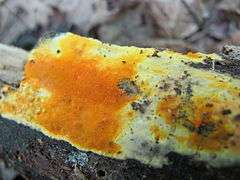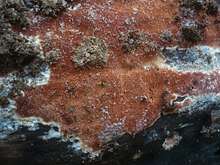Ceriporia
Ceriporia is a widely distributed genus of crust fungi.
| Ceriporia | |
|---|---|
 | |
| Ceriporia spissa | |
| Scientific classification | |
| Kingdom: | |
| Division: | |
| Class: | |
| Order: | |
| Family: | |
| Genus: | Ceriporia Donk (1933) |
| Type species | |
| Ceriporia viridans | |
| Species | |
|
49; see text | |
| Synonyms[1] | |
Taxonomy
The genus was circumscribed by Dutch mycologist Marinus Anton Donk in 1930, with Ceriporia viridans as the type species.[2] The generic name combines the Latin word cera ("wax") and the name Poria.[3]
Molecular phylogenetic analyses have shown that Ceriporia is not monophyletic,[4][5] despite an earlier study which suggested the contrary.[6] The presence or absence of cystidia is not considered a phylogenetic character in delimiting the species of Ceriporia.[4]
Although traditionally classified in the family Phanerochaetaceae,[7] recent molecular phylogenetic analysis supports the placement of Ceriporia in the Irpicaceae.[8][9][10]
Species
A 2008 estimate placed 22 species in the genus.[7] As of September 2016, Index Fungorum accepts 49 species of Ceriporia.[11] Twenty species occur in China;[4] eighteen species are found in the neotropics.[12]
- Ceriporia alachuana (Murrill) Hallenb. (1979) – Dominican Republic
- Ceriporia alania Gilb. & Hemmes (2004)[13]
- Ceriporia alba M.Pieri & B.Rivoire (1997)[14]
- Ceriporia albobrunnea Ryvarden & Iturr. (2003)[15]
- Ceriporia albomellea Yuan Yuan, Jia J.Chen, X.H.Ji (2017) – China[16]
- Ceriporia amazonica A.M.S.Soares, H.M.P.Sotão & Ryvarden (2014)[12] – Brazil
- Ceriporia angulata Gomes-Silva, Ryvarden & Gibertoni (2012)[17] – Brazil
- Ceriporia aurantiocarnescens (Henn.) M.Pieri & B.Rivoire (1997)[14]
- Ceriporia aurea Ryvarden (2014)[18] – Brazil
- Ceriporia bresadolae (Bourdot & Galzin) Donk (1933)
- Ceriporia bubalinomarginata B.S.Jia & Y.C.Dai (2013)[4] – China
- Ceriporia camaresiana (Bourdot & Galzin) Bondartsev & Singer (1941) – Corsica
- Ceriporia citrina M.Mata & Ryvarden (2010)[19] – Costa Rica
- Ceriporia crassitunicata Y.C.Dai & Sheng H.Wu (2002)
- Ceriporia cystidiata Ryvarden & Iturr. (2003)
- Ceriporia davidii (D.A.Reid) M.Pieri & B.Rivoire (1997)[14]
- Ceriporia dentipora Ryvarden (2010)[19] – Costa Rica
- Ceriporia excelsa S.Lundell ex Parmasto (1959) – Europe
- Ceriporia ferrugineocincta (Murrill) Ryvarden (1980) – Puerto Rico
- Ceriporia griseoviolascens M.Pieri & B.Rivoire (1997)[14]
- Ceriporia herinkii Vampola (1996)[20] – Europe
- Ceriporia incrustata M.Mata & Ryvarden (2010)[19] – Costa Rica
- Ceriporia inflata B.S.Jia & B.K.Cui (2012)[21] – China
- Ceriporia jiangxiensis B.S.Jia & B.K.Cui (2012) [21] – China
- Ceriporia lacerata N.Maek., Suhara & R.Kondo (2003)[22]
- Ceriporia leptoderma (Berk. & Broome) Ryvarden (1980) – Uganda
- Ceriporia mellea (Berk. & Broome) Ryvarden (1978) – Uganda; Zaïre
- Ceriporia mellita (Bourdot & Galzin) Bondartsev & Singer (1941) – Great Britain
- Ceriporia merulioidea Ryvarden (2010)[23]
- Ceriporia metamorphosa (Fuckel) Ryvarden & Gilb. (1993) – Europe
- Ceriporia microspora I.Lindblad & Ryvarden (1999)[24]
- Ceriporia nanlingensis B.K.Cui & B.S.Jia (2011)[25] – China
- Ceriporia ochracea Ryvarden (2014)[26]
- Ceriporia otakou (G.Cunn.) P.K.Buchanan & Ryvarden (1988)
- Ceriporia pseudocystidiata B.S.Jia & Y.C.Dai (2013) – China
- Ceriporia purpurea (Fr.) Donk (1971) – Europe
- Ceriporia retamoana Rajchenb. (2000)[27]
- Ceriporia reticulata (Hoffm.) Domanski (1963) – Europe; United States
- Ceriporia rhodella (Fr.) Donk (1933)
- Ceriporia rubescens (Petch) Ryvarden (2015)
- Ceriporia spissa (Schwein. ex Fr.) Rajchenb. (1983) – Great Britain
- Ceriporia straminea Ryvarden (2014)[18]
- Ceriporia subpudorina (Pilát) Bondartsev (1953)
- Ceriporia subspissa Aime & Ryvarden (2007)[28] – Guyana
- Ceriporia tarda (Berk.) Ginns (1984) – United States; Australia
- Ceriporia totara (G.Cunn.) P.K.Buchanan & Ryvarden (1988)
- Ceriporia variegata B.S.Jia & Y.C.Dai (2013)[4] – China
- Ceriporia vermicularis M.Pieri & B.Rivoire (1997)[14]
- Ceriporia viridans (Berk. & Broome) Donk (1933) – Europe
- Ceriporia xylostromatoides (Berk.) Ryvarden (1980)
References
- "Synonymy: Ceriporia Donk". Species Fungorum. CAB International. Retrieved 2015-01-21.
- Donk, M.A. (1933). "Revisie van de Nederlandse Heterobasidiomyceteae (uitgez. Uredinales en Ustilaginales) en Homobasidiomyceteae-Aphyllophraceae: II. Mededelingen van het botanisch Museum en Herbarium van de Rijksuniversiteit Utrecht" (in Dutch). 9: 170. Cite journal requires
|journal=(help) - Donk, M.A. (1960). "The generic names proposed for Polyporaceae". Persoonia. 1 (2): 173–302.
- Jia, B.S.; Zhou, L.W.; Cui, B.K.; Rivoire, B.; Dai, Y.C. (2014). "Taxonomy and phylogeny of Ceriporia (Polyporales, Basidiomycota) with an emphasis of Chinese collections". Mycological Progress. 13: 81–93. doi:10.1007/s11557-013-0895-5.
- Chen, Che-Chih; Chen, Chi-Yu; Lim, Young Woon; Wu, Sheng-Hua (2020-01-02). "Phylogeny and taxonomy of Ceriporia and other related taxa and description of three new species". Mycologia. 112 (1): 64–82. doi:10.1080/00275514.2019.1664097. ISSN 0027-5514. PMID 31906813.
- Kim, Seon Young; Jung, Hack Sung (1999). "Molecular taxonomy of Ceriporia". Mycotaxon. 70: 237–246.
- Kirk, P.M.; Cannon, P.F.; Minter, D.W.; Stalpers, J.A. (2008). Dictionary of the Fungi (10th ed.). Wallingford, UK: CAB International. p. 128. ISBN 978-0-85199-826-8.
- Miettinen, Otto; Spirin, Viacheslav; Vlasák, Josef; Rivoire, Bernard; Stenroos, Spoili; Hibbett, David S. (2016). "Polypores and genus concepts in Phanerochaetaceae (Polyporales, Basidiomycota)". MycoKeys. 17: 1–46. doi:10.3897/mycokeys.17.10153.

- Justo, Alfredo; Miettinen, Otto; Floudas, Dimitrios; Ortiz-Santana, Beatriz; Sjökvist, Elisabet; Lindner, Daniel; Nakasone, Karen; Niemelä, Tuomo; Larsson, Karl-Henrik; Ryvarden, Leif; Hibbett, David S. (2017). "A revised family-level classification of the Polyporales (Basidiomycota)". Fungal Biology. 121 (9): 798–824. doi:10.1016/j.funbio.2017.05.010. PMID 28800851.
- Chen, Che-Chih; Chen, Chi-Yu; Lim, Young Woon; Wu, Sheng-Hua (2020-01-02). "Phylogeny and taxonomy of Ceriporia and other related taxa and description of three new species". Mycologia. 112 (1): 64–82. doi:10.1080/00275514.2019.1664097. ISSN 0027-5514. PMID 31906813.
- Kirk PM. "Species Fungorum (version 22nd December 2014). In: Species 2000 & ITIS Catalogue of Life". Retrieved 2015-01-21.
- Soares, A.M.S.; Sotão, H.M.P.; Ryvarden, L.; Gibertoni, T.B. (2014). "Ceriporia amazonica (Phanerochaetaceae, Basidiomycota), a new species from the Brazilian Amazonia and C. albobrunea Ryvarden & Iturriaga new to Brazil". Phytotaxa. 175: 176–180. doi:10.11646/phytotaxa.175.3.9.
- Gilbertson, R.L.; Hemmes, D.E. (2004). "New species of lignicolous basidiomycetes from Hawaii". Memoirs of the New York Botanical Garden. 89: 81–92.
- Pieri, M.; Rivoire, B. (1997). "A propos du genre Ceriporia Donk (Aphyllophoromycetidae)". Bulletin de la Société Mycologique de France. 113 (3): 193–250.
- Ryvarden, L.; Iturriaga, T. (2003). "Studies in neotropical polypores 10. New polypores from Venezuela". Mycologia. 95 (6): 1066–1077. doi:10.1080/15572536.2004.11833021. JSTOR 3761913. PMID 21149014.
- Yuan, Yuan; Ji, Xiao-Hong; Wu, Fang; Chen, Jia-Jia (2017). "Ceriporia albomellea (Phanerochaetaceae, Basidiomycota), a new species from tropical China based on morphological and molecular evidences". Phytotaxa. 298 (1): 20–28. doi:10.11646/phytotaxa.298.1.2.
- Gomes-Silva, A.C.; Ryvarden, L.; Gibertoni, T.B. (2012). "Resupinate poroid fungi from tropical rain forests in Brazil: two new species and new records". Mycological Progress. 11: 879–885. doi:10.1007/s11557-011-0803-9.
- Ryvarden, L. (2014). "Studies in Neotropical polypores 37. Some new and interesting species from tropical America". Synopsis Fungorum. 32: 58–67.
- Mata, M.; Ryvarden, L. (2010). "Studies in neotropical polypores 27. More new and interesting species from Costa Rica". Synopsis Fungorum. 27: 59–72.
- Vampola, P.; Pouzar, Z. (1996). "Notes on some species of genera Ceriporia and Ceriporiopsis (Polyporaceae)". Czech Mycology. 48 (4): 315–324.
- Jia, Bi-Si; Cui, Bao-Kai (2012). "Ceriporia (Basidiomycota, Polyporales) from China with a description of two new species". Mycotaxon. 121: 305–312. doi:10.5248/121.305.
- Suhara, H.; Maekawa, N.; Kaneko, S.; Hattori, T.; Sakai, K.; Kondo, R. (2003). "A new species, Ceriporia lacerate, isolated from white-rotted wood". Mycotaxon. 86: 335–347.
- Læssøe, T.; Ryvarden, L. (2010). "Studies in Neotropical polypores 26. Some new and rarely recorded polypores from Ecuador". Synopsis Fungorum. 27: 34–58.
- Lindblad, Irene; Ryvarden, Leif (1999). "Studies in neotropical polypores. 3. New and interesting Basidiomycetes (Poriales) from Costa Rica". Mycotaxon. 71: 335–359.
- Jia, B.S.; Cui, B.K. (2011). "Notes on Ceriporia (Basidiomycota, Polyporales) in China". Mycotaxon. 116: 457–468. doi:10.5248/116.457.
- Ryvarden, L. (2014). "Errata". Synopsis Fungorum. 32: 79–80.
- Rajchenberg, M. (2000). "The genus Ceriporia Donk (Polyporaceae) in Patagonian Andes Forests of Argentina". Karstenia. 40 (1–2): 143–146.
- Aime, L.; Ryvarden, L.; Henkel, T.W. (2007). "Studies in Neotropical polypores 22. Additional new and rare species from Guyana". Synopsis Fungorum. 23: 15–31.
